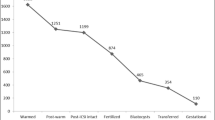Abstract
Purpose
To evaluate whether oocyte dysmorphisms affect oocyte survival rates in an egg-cryobanking donation program.
Methods
This study included 54 patients undergoing intracytoplasmic sperm injection. A total of 415 metaphase II oocytes were vitrified using the Cryotop method. Oocyte morphology was assessed immediately prior to oocyte vitrification under 400× magnification. The influence of dysmorphisms on post-thaw survival rates was assessed using regression analysis. Results were considered to be significant at the 5% critical level.
Results
Oocyte survival rate was not affected by the presence of the following analysed oocyte abnormalities: increased cytoplasmic granularity, vacuoles in the ooplasm, aggregates of smooth endoplasmic reticulum in the ooplasm, large perivitelline space size, perivitelline space granularity, fragmented first polar body and zona pellucida abnormalities.
Conclusions
Oocyte morphology, observed prior to vitrification, does not predict post-warming survival. The non-invasive identification of predictive markers for oocyte survival potential remains a difficult task.
Similar content being viewed by others
References
Cobo A, Diaz C. Clinical application of oocyte vitrification: a systematic review and meta-analysis of randomized controlled trials. Fertil Steril. 2011;96:277–85.
Gook DA, Edgar DH. Human oocyte cryopreservation. Hum Reprod Update. 2007;13:591–605.
Smith GD, Motta EE, Serafini P. Theoretical and experimental basis of oocyte vitrification. Reprod Biomed Online. 2011;23:298–306.
Jones A, Van Blerkom J, Davis P, Toledo AA. Cryopreservation of metaphase II human oocytes effects mitochondrial membrane potential: implications for developmental competence. Hum Reprod. 2004;19:1861–6.
Carroll J, Depypere H, Matthews CD. Freeze-thaw-induced changes of the zona pellucida explains decreased rates of fertilization in frozen-thawed mouse oocytes. J Reprod Fertil. 1990;90:547–53.
Fuku E, Xia L, Downey BR. Ultrastructural changes in bovine oocytes cryopreserved by vitrification. Cryobiology. 1995;32:139–56.
Vincent C, Pruliere G, Pajot-Augy E, Campion E, Garnier V, Renard JP. Effects of cryoprotectants on actin filaments during the cryopreservation of one-cell rabbit embryos. Cryobiology. 1990;27:9–23.
Le Gal F, Gasqui P, Renard JP. Differential osmotic behavior of mammalian oocytes before and after maturation: a quantitative analysis using goat oocytes as a model. Cryobiology. 1994;31:154–70.
Magistrini M, Szollosi D. Effects of cold and of isopropyl-N-phenylcarbamate on the second meiotic spindle of mouse oocytes. Eur J Cell Biol. 1980;22:699–707.
Tharasanit T, Colenbrander B, Stout TA. Effect of maturation stage at cryopreservation on post-thaw cytoskeleton quality and fertilizability of equine oocytes. Mol Reprod Dev. 2006;73:627–37.
Wu J, Zhang L, Wang X. In vitro maturation, fertilization and embryo development after ultrarapid freezing of immature human oocytes. Reproduction. 2001;121:389–93.
Pickering SJ, Braude PR, Johnson MH, Cant A, Currie J. Transient cooling to room temperature can cause irreversible disruption of the meiotic spindle in the human oocyte. Fertil Steril. 1990;54:102–8.
Nottola SA, Macchiarelli G, Coticchio G, et al. Ultrastructure of human mature oocytes after slow cooling cryopreservation using different sucrose concentrations. Hum Reprod. 2007;22:1123–33.
Van der Elst J, Van den Abbeel E, Jacobs R, Wisse E, Van Steirteghem A. Effect of 1,2-propanediol and dimethylsulphoxide on the meiotic spindle of the mouse oocyte. Hum Reprod. 1988;3:960–7.
Rienzi L, Martinez F, Ubaldi F, et al. Polscope analysis of meiotic spindle changes in living metaphase II human oocytes during the freezing and thawing procedures. Hum Reprod. 2004;19:655–9.
Figueira RD, de Almeida Ferreira Braga DP, Semiao-Francisco L, Madaschi C, Iaconelli A, Iaconelli Jr A, Borges Jr E. Metaphase II human oocyte morphology: contributing factors and effects on fertilization potential and embryo developmental ability in ICSI cycles. Fertil Steril. 2010;94:1115–7.
Parmegiani L, Cognigni GE, Bernardi S, et al. Freezing within 2 h from oocyte retrieval increases the efficiency of human oocyte cryopreservation when using a slow freezing/rapid thawing protocol with high sucrose concentration. Hum Reprod. 2008;23:1771–7.
Fosas N, Marina F, Torres PJ, et al. The births of five Spanish babies from cryopreserved donated oocytes. Hum Reprod. 2003;18:1417–21.
Kuwayama M, Vajta G, Kato O, Leibo SP. Highly efficient vitrification method for cryopreservation of human oocytes. Reprod Biomed Online. 2005;11:300–8.
Cobo A, Meseguer M, Remohi J, Pellicer A. Use of cryo-banked oocytes in an ovum donation programme: a prospective, randomized, controlled, clinical trial. Hum Reprod. 2010;25:2239–46.
Gook DA, Osborn SM, Johnston WI. Cryopreservation of mouse and human oocytes using 1,2-propanediol and the configuration of the meiotic spindle. Hum Reprod. 1993;8:1101–9.
Vincent C, Pickering SJ, Johnson MH, Quick SJ. Dimethylsulphoxide affects the organisation of microfilaments in the mouse oocyte. Mol Reprod Dev. 1990;26:227–35.
Fabbri R, Porcu E, Marsella T, Rocchetta G, Venturoli S, Flamigni C. Human oocyte cryopreservation: new perspectives regarding oocyte survival. Hum Reprod. 2001;16:411–6.
Balaban B, Urman B. Effect of oocyte morphology on embryo development and implantation. Reprod Biomed Online. 2006;12:608–15.
Rienzi L, Vajta G, Ubaldi F. Predictive value of oocyte morphology in human IVF: a systematic review of the literature. Hum Reprod Update. 2010;17:34–45.
Otsuki J, Okada A, Morimoto K, Nagai Y, Kubo H. The relationship between pregnancy outcome and smooth endoplasmic reticulum clusters in MII human oocytes. Hum Reprod. 2004;19:1591–7.
Kahraman S, Yakin K, Donmez E, et al. Relationship between granular cytoplasm of oocytes and pregnancy outcome following intracytoplasmic sperm injection. Hum Reprod. 2000;15:2390–3.
Ebner T, Moser M, Tews G. Is oocyte morphology prognostic of embryo developmental potential after ICSI? Reprod Biomed Online. 2006;12:507–12.
ALPHA Scientists In Reproductive Medicine; ESHRE Special Interest Group Embryology. The Istanbul consensus workshop on embryo assessment: proceedings of an expert meeting. Hum Reprod. 2011;26:1270–83.
Setti AS, Figueira RC, Braga DP, Colturato SS, Iaconelli A Jr., Borges E Jr. Relationship between oocyte abnormal morphology and intracytoplasmic sperm injection outcomes: a meta-analysis. Eur J Obstet Gynecol Reprod Biol In press.
Maldonaldo I, Bermudez A, Varghese A, Gaytan J, Sharma R, Agarwal A. Oocyte dysmorphism is not a limiting factor for post-thaw survival following vitrification by cryotop method. Fertil Steril. 2008;90:S283.
Author information
Authors and Affiliations
Corresponding author
Additional information
Capsule
Oocyte morphology, observed prior to vitrification, does not predict post-warming survival.
Rights and permissions
About this article
Cite this article
Setti, A.S., Figueira, R.d.C.S., Braga, D.P.d.A.F. et al. Oocyte morphology does not affect post-warming survival rate in an egg-cryobanking donation program. J Assist Reprod Genet 28, 1177–1181 (2011). https://doi.org/10.1007/s10815-011-9677-7
Received:
Accepted:
Published:
Issue Date:
DOI: https://doi.org/10.1007/s10815-011-9677-7




